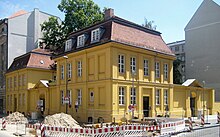Titus de Favre
Titus de Favre (* end of the 17th century , † 1745 ) was a German architect Walloon origin, at the end of the reign of King Friedrich Wilhelm I as chief architect in Berlin worked.
Live and act
Titus de Favre was called to Berlin by King Friedrich Wilhelm I of the Netherlands in March 1737 to succeed Philipp Gerlach as senior construction director. According to various sources, Favre also had the title of master builder. Since he only worked in Berlin for five years, only a few buildings can be traced back to him, especially since the authorities accused him of “inactivity” during his tenure.
In 1737, Favre submitted a draft for the reconstruction of the tower of the Petrikirche in Berlin , which collapsed in 1734 . In 1738 he took over the management of the building together with the chief building director Johann Carl Stoltze , which however remained unfinished. From 1737 to 1739 the master mason Christian August Naumann built the Trinity Church in Mauerstraße according to Favres, probably with Stoltze's participation . The rectories of the church in Taubenstrasse / corner Glinkastrasse, which was destroyed in World War II , also designed by Favre and executed by Naumann, have been partially preserved to this day and are thus the oldest surviving residential buildings in Friedrichstadt .
Favre planned a number of bridges in Berlin. In 1738 the Spitalbrücke was built over the moat to Friedrichstadt. It was decorated with a Doric column portico made of wood. Also in 1738, the dog bridge, designed as a bascule bridge by court carpenter Johann Andreas Adam Büring , replaced a previous building from the 16th century. From 1821 to 1824 it was replaced by the castle bridge that has been preserved to this day . The Gertraudenbrücke was built in 1739 as a wooden bascule bridge, also based on Favre's plans.
Favre began a renovation of the Gertraudenkirche on Spittelmarkt in 1739 according to plans by Friedrich Wilhelm Diterichs . The church was demolished in 1872 after Karl Friedrich Schinkel's redesign projects were not implemented.
Under King Frederick II , Favre was only active in the provinces. Georg Wenzeslaus von Knobelsdorff was in charge of the tower building of the Petrikirche , while Favre had to devote himself to subordinate construction projects such as the repair of paths in Fürstenwalde , Angermünde , Schwedt , Frankfurt (Oder) , Küstrin and Landsberg an der Warthe . Although his field of work included the "fortress and residence construction", these tasks were apparently underrepresented for Favre. In November 1742, Favre replied to the accusation of "inactivity" raised by the Minister von Happe : [A] except that [I] in that year attended visits to their magazines in Frankfurt a. Or, Cüstrin and Landsberg a. Warthe, traveled the military roads and routes from Berlin, instructed and worried about their repairs, but otherwise found nothing more to do without the work that took place at the local fortification building and the associated invoices . This assessment was unusual in view of the constant workload of the master builders working under Friedrich II and testified to the very limited workload of the architect.
Titus de Favre, who died in 1745, was one of the teachers of the architect Johann Gottfried Büring alongside Johann Carl Stoltze .
literature
- Hermann Heckmann : Builder of the Baroque and Rococo in Brandenburg-Prussia. Berlin 1998, ISBN 3-345-00631-6
| personal data | |
|---|---|
| SURNAME | Favre, Titus de |
| ALTERNATIVE NAMES | Favre, Titus |
| BRIEF DESCRIPTION | German architect and senior construction director |
| DATE OF BIRTH | 17th century |
| DATE OF DEATH | 1745 |
